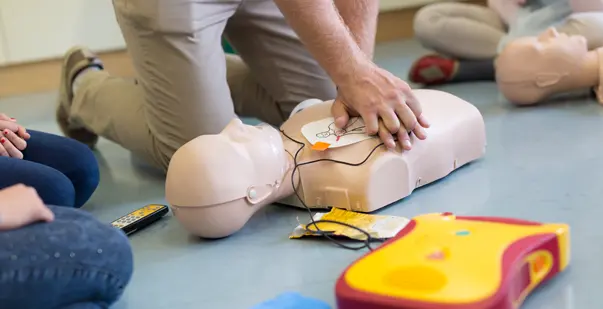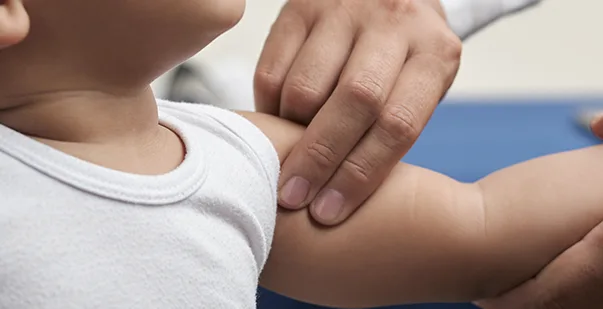It can be scary to see someone collapsing in front of you. Isn’t it? What would you want to do in such a situation? Wouldn’t you feel helpless if you did not know how to help? Experiencing sudden cardiac arrest affects a large number of Americans every year. Among them, only 70–90% of individuals end up surviving.
You must respond early to sudden cardiac arrests to improve these statistics. Automated external defibrillator (AED) training is a very useful skill. Having certification can prepare you to handle crises during emergencies. So what is AED? In this blog, learn more about its certification.
What is AED certification?
What is an AED certification? AED training offers a 2-year certification and follows 2015 guidelines and OSHA compliance. It covers child, adult, and infant CPR, choking, and skills that help you respond to an emergency. The course is taught by skilled instructors. The training required in-person skill testing while covering major topics such as bloodborne pathogens, injuries, recovery positions, medical emergencies, and environmental emergencies.
Here are the most essential things you need to know about using an AED:
AEDs deliver a defibrillation shock to people who need it. Once attached, an AED will read the person’s heart rhythm. It helps determine if they need a defibrillation shock.
Everyone must feel comfortable using an AED. The AED offers you clear audio and visual instructions at every step of the way.
When do you need to use an AED?
AEDs will walk you through the process. They are easy to use in the following situations:
Cardiac arrest: When a person’s heart starts malfunctioning, it is considered fatal.
Ventricular fibrillation: When the lower chambers of the heart contract, it leads to an irregular heart rhythm. This stops the blood from pumping.
Ventricular tachycardia: A heart rhythm condition due to irregular signals in the lower chambers of the heart.
Why should you learn using an AED?
An AED brings heart rhythm back. This is why you will be able to find one during an emergency. All 50 states in the United States have made AEDs a mandate in public locations.
Read more: CPR AED course in Oakville
Why is AED training crucial?
More than 300,000 Americans suffer from an out-of-hospital cardiac arrest. It can be fatal unless life-saving techniques are performed promptly. AED training helps reduce the death toll from cardiac arrests. This keeps the blood flowing until emergency services arrive. Keep reading to understand why AED training is crucial.
- Increased survival rates:
AED training makes bystanders and first responders more likely to swiftly intervene during a sudden cardiac arrest. Studies have shown that the immediate use of an AED increases survival rates by 50%. The training involves steps such as recognizing cardiac arrest, performing CPR, and applying AED pads efficiently. This helps responders act confidently during a crisis. - It makes you confident and enhances your readiness:
Proper training in AED makes you confident among potential users. This reduces hesitation and improves response times. You can learn ways to use AED successfully and follow the instructions well. This helps you overcome fear, enabling you to respond calmly. - Mitigate risks and comply legally:
Organizations providing AED training prioritize safety but also meet all regulatory requirements. Effective training equips learners to be responsible and handle emergencies effectively. Compliance with training protocols reduces liability risks and shows commitment to securing the well-being of employees and visitors. - Empowers communities:
AED training extends beyond workplaces and empowers entire communities. Schools, residential areas, and public organizations can respond promptly to emergencies. Communities that invest in AED programs create a safer environment. This helps everyone feel secure, knowing that assistance is ready whenever required. - Maintains skills over time:
Regular AED training ensures that learners are updated with the latest skills. This helps them learn the latest techniques and skills. This ongoing education creates a culture in which everyone is prepared. It also ensures that trained individuals are equipped to assist whenever the need arises.
What does an AED certification mean?
AED certification signifies a person is trained to use an AED device and save a life. Although AEDs are easy to use by laypeople, the formal certification procedure teaches you the following:
- The dos and don’ts of using an AED to respond to a cardiac emergency. This includes the location of places to use the pads and to place yourself when the AED delivers a shock to stay safe.
- The chain of survival shows the steps you need to take and the order you need to follow.
How to use an AED?
Using an automated external defibrillator is critical to saving lives during cardiac arrest. These are user-friendly and provide clear instructions to guide individuals when delivering shocks to the heart. It is crucial to understand ways to use an AED to increase survival chances during emergencies. Learn the steps to use an AED:
- Inspect the scene:
As the primary step, ensure that you are safe. Then check for responsiveness and call for emergency help immediately. - Prepare the victim:
Lay the victim on the back. Expose the chest and remove any clothing. Dry the skin if it is wet. - Apply the AED pads:
Turn the AED and follow the voice and visual prompts provided. Place the pads well, as shown in the diagrams, on the bare chest. - Follow the instructions:
Once you attach the pads, the device will quickly analyze the heart rhythm. Do not touch the victim. Resume CPR immediately once you deliver the shock.
These steps are crucial to ensuring the efficiency of the AED and restoring the normal functioning of the heart.
Who can benefit from CPR/AED certification?
CPR/AED is valuable for several individuals, including the following:
- Laypersons:
Anyone can seek CPR/AED certification, as cardiac arrests happen anywhere. Caregivers, parents, and teachers are prepared to respond timely. - Healthcare providers:
Healthcare professionals, including nurses, EMTs’, doctors, and paramedics, must maintain CPR/AED certification. BLS certification is essential for these roles. - Workplace:
Workplace settings such as factories, offices, and construction sites need employees to hold the certification. - Educational institutions:
Teachers, staff, and coaches can benefit from the certification. It will equip them to ensure the safety of athletes and students. - Childcare providers:
Individuals in childcare settings need this certification to respond effectively to pediatric emergencies. - Community organizations:
Members of sports clubs can enhance community safety.
Read more: Using AEDs on Children and Infants: How to Save A Young Life
How to maintain CPR/AED certification?
Here’s how to obtain and maintain your CPR/AED certification:
- Choose a certification provider:
Select a provider offering CPR/AED courses ideal for your needs. Research various organizations and training locations to find one that fits preferences and schedules. - Attend a certification course:
Enroll online. Courses differ and vary in length. Participate in hands-on training. - Complete training:
Participate in the course actively. Learn the skills and show your competence with the help of exams. - Receive certification:
Upon successful completion of the course, you will receive a CPR/AED certification card. This indicates the expiration and certification dates. - Renew certification:
CPR and AED have an expiration date. This is valid for two years. You must maintain your certification and renew it on time. - Stay informed and practice:
Stay informed about changes in CPR/AED guidelines. Review your skills to be ready for all emergencies.
AED certification FAQs
Is AED certification the same as CPR certification?
Regular CPR training covers how to use an AED. If you are going to get CPR certified, it is recommended that you choose a training session. This covers both CPR and AED, since these are closely related.
Do you need to be certified to use an AED?
No. AEDs are designed for users with limited training. These devices are user-friendly and safe to use. This will not be a shock to anyone suffering from a fatal heart rhythm.
How long does it take to be CPR certified?
If you want to be CPR certified, it takes 1–5 hours. A CPR class time frame can vary, depending on the provider.
Is AED training required by law?
Yes, AED training requirements vary by state. 45 out of 50 states in the United States need some level of AED training for responders. In a few states, AED training is crucial for graduation from middle school, high school, or a specific grade level.
Conclusion
Now that you know what is AED, you can easily prepare for emergencies. Certification helps you learn crucial skills to respond to emergencies. Being certified makes you confident and meets your standards and requirements. Regular renewals are recommended to keep the skills current and enhance readiness to respond to emergencies effectively.










